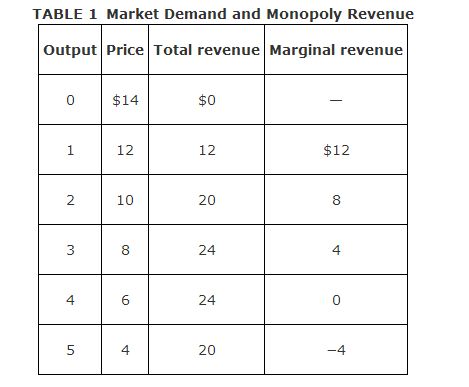Demand in a Monopolistic Market
Because the monopolist is the market's only supplier, the demand curve the monopolist faces is the market demand curve. You will recall that the market demand curve is downward sloping, reflecting the law of demand. The fact that the monopolist faces a downward‐sloping demand curve implies that the price a monopolist can expect to receive for its output will not remain constant as the monopolist increases its output.
Price‐searching behavior. Unlike a perfectly competitive firm, the monopolist does not have to simply take the market price as given. Instead, the monopolist is a price searcher; it searches the market demand curve for the profit maximizing price. The monopolist's search for the profit maximizing price involves comparing the marginal revenue and marginal cost associated with each possible price‐output combination on the market demand curve.
Declining marginal revenue and price. The monopolist's marginal revenue from each unit sold does not remain constant as in the case of the perfectly competitive firm. The monopolist faces the downward‐sloping market demand curve, so the price that the monopolist can get for each additional unit of output must fall as the monopolist increases its output. Consequently, the monopolist's marginal revenue will also be falling as the monopolist increases its output. If it is assumed that the monopolist cannot price discriminate, that is, charge a different price for each unit of output it produces, then the monopolist's marginal revenue from each additional unit produced will not equal the price that the monopolist charges. In fact, the marginal revenue that the monopolist receives from producing an additional unit of output will always be less than the price that the monopolist can charge for the additional unit.
To understand why, consider a monopolist that is currently supplying N units of output. Suppose the monopolist decides to supply 1 more unit. It therefore increases its supply to N + 1 units of output. The downward‐sloping market demand curve indicates that the new market price will be lower than before. Because the monopolist cannot price discriminate, it will have to sell all N + 1 units of output at the new lower price. This new lower price reduces the total revenue that the monopolist receives from the first N units sold. At the same time, the monopolist will gain some revenue from the additional unit it supplies. The marginal revenue that the monopolist receives from supplying 1 additional unit is equal to the price that it receives for this unit minus its loss in revenue from having to sell N units of output at a lower market price. Thus, the price the monopolist receives from selling N + 1 units exceeds the marginal revenue that it receives from supplying the additional unit of output.
The relationship between marginal revenue and price in a monopolistic market is best understood by considering a numerical example, such as the one provided in Table .

The first two columns of Table , labeled “Output” and “Price,” represent the market demand schedule that the monopolist faces. As the price falls, the market's demand for output increases, in keeping with the law of demand. The third column reports the total revenue that the monopolist receives from each different level of output. The fourth column reports the monopolist's marginal revenue that is just the change in total revenue per 1 unit change of output. Note that the monopolist's marginal revenue is declining as output increases.
Suppose the monopolist is currently producing 2 units of output for which it is receiving a price of $10 per unit and a total revenue of $20 (2 × $10). Now, consider what happens when the monopolist increases its output to 3 units. The price that the monopolist can expect to receive falls to $8 per unit. At this new lower price, the total revenue the monopolist receives for the first two units of output it supplies falls from $20 to $16 (2 × $8), a loss of $4. The monopolist's marginal revenue is equal to the $8 that it receives from the third unit sold minus the loss in total revenue that it receives on the first two units due to the new lower price. Hence, the marginal revenue the monopolist receives from the third unit sold is $8 − $4 = $4, which is below the market price of $8.